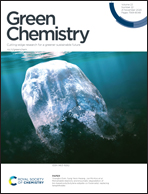Profitable biomethane production from delignified rice straw biomass: the effect of lignin, energy and economic analysis†
Abstract
In this study, a cost and time saving strategy for the recovery of biomethane from rice straw using a novel phase-separation delignification process prior to bacterial pretreatment (BP) has been reported. The rice straw was subjected to delignification using mechanical homogenization to remove its lignin content, which enhanced the mass transfer of cellulose to the second step, the cellulase secreting bacterial pretreatment (CBP) process. The results showed that a higher lignin removal efficiency of 72% was achieved at an optimal biomass to water ratio of 0.04 (w/v) and a specific energy input of 114.3 kJ kg−1 TS. With a pretreatment time of 24 h, the delignified rice straw with the cellulase secreting Bacillus sp. pretreatment process resulted in the formation of higher fractions of soluble organics (38.2%), cellulose (35.2%), and hemicellulose (31.8%) than CBP (22.92%, 21.2%, and 19.1%) and the control (3.43%, 3.16%, and 2.9%), respectively. The D-CBP (delignified cellulase secreting bacterially pretreated) rice straw samples achieved a maximum lignin content of 0.5 g L−1 that did not inhibit the methanogenesis process, resulting in a specific biomethane production of 165 mL g−1 VS. The results from large scale energy balance analysis revealed that D-CBP saved a maximum energy of 769.08 kW h ton−1. The results from economic analysis for D-CBP indicated a net profit of 134.89 USD per ton and a cost–benefit ratio of 1.52 which were better than CBP (−86.07 USD per ton and 0.71).



 Please wait while we load your content...
Please wait while we load your content...